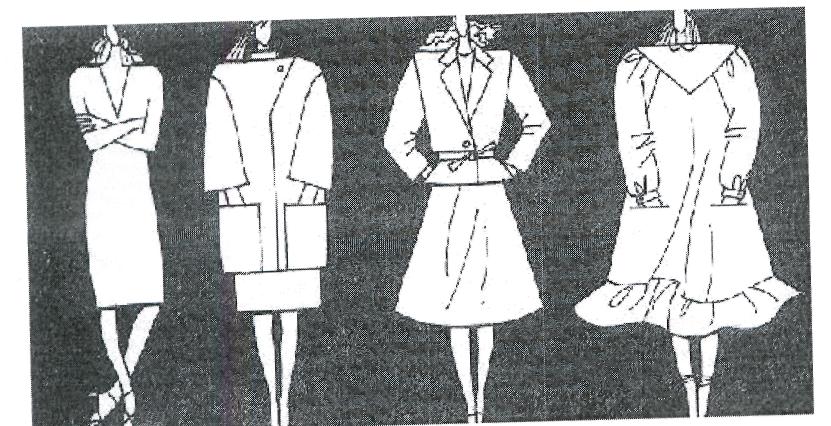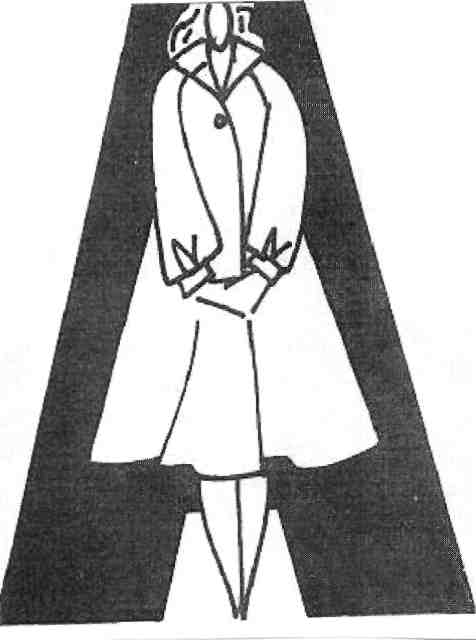
- •Шахты 2012
- •Содержание
- •Предисловие
- •Lesson One. Clothing and Textile Materials
- •Text a. Origin and Functions of Clothing
- •Vocabulary
- •Exercise 7. Say what you have learned from the text about:
- •Text b. Clothing, Costume and Dress
- •Vocabulary
- •Exercise 8. Read the text “Clothing, Costume and Dress” and translate in into Russian. Exercise 9. Fill in the blanks with the English equivalents of the Russian “платье”, “одежда”:
- •Distinctions among Clothing, Costume and Dress
- •Vocabulary
- •Lesson Two. Men’s and Women’s Clothing
- •Vocabulary
- •Text b. Caftan and Coat
- •Exercise 6. Read the text “Caftan and Coat” and think over the answers to the questions.
- •Vocabulary
- •Exercise 7. Complete the sentences using the text:
- •Exercise 8. Translate the reading selection given below. Reproduce the coloured version of the styles described.
- •Exercise 9. Say what you have learnt from the text about
- •Vocabulary
- •Lesson Three. Styles, Details and Silhouettes
- •Text a. Jacket Styles
- •Vocabulary
- •Text b. Parts of a Suit
- •Vocabulary
- •Exercise 7. Decide if the following statements are true or false.
- •Exercise 8. Look through the fashion magazines and watch tv programmes to describe updated suit styles offered by designers and worn by famous people (businessmen, politicians and so on).
- •Text c. Types of Fashion Silhouettes
- •Vocabulary
- •Lesson Four. Parts of Clothes
- •Text a. Sleeve Styles for Women’s Clothes
- •Vocabulary
- •Exercise 1. Read the text «Sleeve Styles for Women’s Clothes” to find the answers to the questions.
- •Exercise 2. Find and translate the sentences in which the following words are used. Determine what part of speech they belong to.
- •Exercise 3. Read the text once more for better understanding. Match the following descriptions 1-5 with the type of sleeve (a-e).
- •Exercise 4. Decide whether these sentences are true or false.
- •Exercise 5. Put the following words in order to make some questions for your partner.
- •Text b. Garments and their Parts
- •Vocabulary
- •Lesson Five. History of Garment Construction
- •Text a. Garment Construction
- •Vocabulary
- •Text b. Garment Construction
- •Vocabulary
- •Text c. History of Clothes and Design
- •Lesson Six. Clothes Design
- •Text a. Fashion Design
- •Vocabulary
- •Text b. Types of Fashion
- •Vocabulary
- •Vocabulary
- •Exercise 8. Read the text (several times) to better understand its contents. Answer the questions.
- •Lesson Seven. Elements and Types of Design
- •Text a. Elements of Design: Line and Form
- •Vocabulary
- •Text b. Elements of Design: Shapes
- •Vocabulary
- •Exercise 5. Return to the text “Elements of Design: Shapes” to decide whether the following statements are true or false.
- •Exercise 6. Translate the sentences paying attention to the word “one”.
- •Exercise 7. Choose the correct answer to match the shape of the garment and its description.
- •Text c. Elements and Types of Design
- •Text a. Fabric Trimmings
- •Vocabulary
- •Exercise 1. Return to the text “Trimmings” to answer the questions.
- •Exercise 2. Translate in writing the sentences with modal verbs can, may, must from the text. Exercise 3. Read the following sentences and translate them into Russian. Pay attention to the word wear.
- •Exercise 4. Read the dialogues and retell them in indirect speech.
- •Text b. Fashion Accessories
- •Vocabulary
- •Lesson Nine. Clothes and Technological Advances
- •Text a. Innovative Clothes
- •Vocabulary
- •Exercise 3. Translate the sentences with the infinitive constructions from a) into Russian and from b) into English.
- •Exercise 4. Write the summary of the text and reproduce it orally. Text b. Innovations in Fashion Design and Garment Production
- •Vocabulary
- •Exercise 5. Read the text “Innovations in Garment Production” several times to better understand its contents. Answer the questions.
- •Exercise 6. Find the English equivalents in the text:
- •Vocabulary
- •Lesson Ten
- •Text a. Techno Material
- •Vocabulary
- •Exercise 1. Return to the text “Techno Materials” to read it more attentively and answer the questions.
- •Exercise 2. Translate the sentences paying attention to the words with -ing.
- •Exercise 3. Write the summary of the text. Text b. Innovative Textiles
- •Vocabulary
- •Exercise 4. Read the text “Innovative Textiles” several times to better understand its contents. Exercise 5. Translate the words of the same root. State to what part of speech they belong:
- •Exercise 6. Rearrange the sentences to correspond the contents of the text.
- •Библиографический список
Exercise 8. Look through the fashion magazines and watch tv programmes to describe updated suit styles offered by designers and worn by famous people (businessmen, politicians and so on).
Reading for general understanding.
Text c. Types of Fashion Silhouettes
Clothing silhouette is the area of a garment, which is defined by its outer profile. There are close-fitting, straight, extended, and bell-shaped silhouettes.

|
In this picture you see so-called A-Line silhouette characterized by shift shoulders, very often with raglan sleeves. Clothes is expanded down to bottom margin without a band. The shape of the clothes looks like letter A.
|
A fashion silhouette is the shape which clothing and undergarments give the body in the attire of a definite period. Shapes and silhouettes in fashion change over time. Many periods in women’s fashion even have a distinct silhouette that we can easily associate with the clothing of that decade or era.
Edwardian Silhouettes
The Edwardian silhouette is often described as an S-Curve. Corsets changed during this period, allowing more space at the front of the body, but less at the sides of the waist. The overall shape was wasp-waisted with a monobosom or pigeon chested effect at the bust.
The Roaring '20s
One of the biggest changes in fashion silhouettes was in the 1920s. The wasp-waisted and matronly look of the Edwardian era was replaced by a clean, rectangular shape with no bust, waist or hip definition. Drop waists, soft fluid fabrics and breast binding were typical to achieve the silhouette of the roaring '20s.
Glamour and Practicality
Silhouettes of the 1930s and 40s were relatively similar. Shoulders were strong and there was clear waist definition in both casual and more formal wear. Clothing fit closer to the body, in part due to fabric rationing in the war years. The body was not exaggerated by these fashion silhouettes and they worked well with many body types, unlike the boyish figure of the 1920s.
The New Look
The end of World War II brought about a new fashion silhouette. The waist was tiny, thanks to shapers and girdles and skirts were full, with crinolines adding to their fullness. The bullet or cone bra and fitted tops and sweaters completed this overall look. This is the stereotypical 1950s fashion silhouette.
Silhouettes in Modern Fashion
The straight shifts made famous by Jackie Kennedy represent the most familiar silhouette of the 1960s and the broad shoulders of power suits remind many of us of the 1980s, but these are not the only or even the primary fashions of the time. While fashion magazines from the 1960s onward have occasionally hailed a fashion silhouette as representative of the year or decade, changes in style and undergarments have made fashion more variable and less about set shapes or silhouettes
Vocabulary
bullet or cone bra n |
- |
бюстгальтер конусовидной формы |
curve n |
- |
изгиб |
drop waist n |
- |
заниженная линия талии |
to exaggerate v |
- |
преувеличивать, чрезмерно подчеркивать |
to hail v |
- |
провозглашать |
outer profile n |
- |
внешний контур, очертание |
rectangular adj |
- |
прямоугольный |
tiny adj |
- |
очень маленький, крошечный |
shape n |
- |
форма |
shift shoulders n |
- |
спущенные плечи |
wasp-waisted |
- |
с осиной талией (напоминающей осу) |
Exercise 9. Return to the text “Types of Fashion Silhouettes” to find the English equivalents. Consult them while translating the text.
Плотно облегающий фигуру… и имеющий форму колокола силуэт; нижний край (низ) одежды; большие пространства в передней части тела; сходство с очертаниями голубиного зоба; мягкие, струящиеся ткани; четкая линия талии; нормирование ткани в военные годы; принес новый модный силуэт; менее зависимая от установленных форм или силуэтов; повседневная одежда; нижнее белье.
Exercise 10. Ask your partner to name:
clothing silhouettes and fashion silhouettes as it is given in the text;
the main features of silhouettes of the 1930s and 40s;
the silhouette popular in the 1950s.
Exercise 11. Answer the questions on the text.
What helps people associate the clothing of the decade or historical period?
How was monobosom or pigeon chested effect achieved in the Edwardian silhouette?
Why didn’t the silhouette of the roaring ‘20s work well with many body types? Do you think it may return back?
Can a single person influence the fashion? Prove your position.
What silhouette or silhouettes represent the 2010s?
Exercise 12. Take 2 pictures of suits/dresses typical to different historical periods. Ask your partner to describe the difference between them in silhouette and details.

